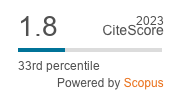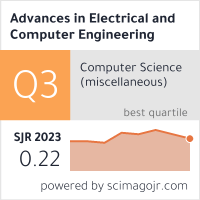| 1/2023 - 6 |
Multi-Period Transmission Switching Strategy Analysis Considering Thermal Unit CommitmentLAM, L. H. |
| Extra paper information in |
| Click to see author's profile in |
| Download PDF |
Author keywords
power system analysis computing, mathematical programming, electrical engineering, power generation economics, mathematical model
References keywords
power(28), switching(20), transmission(16), tpwrs(15), optimal(11), neill(7), oren(6), hedman(6), fisher(6), systems(5)
Blue keywords are present in both the references section and the paper title.
About this article
Date of Publication: 2023-02-28
Volume 23, Issue 1, Year 2023, On page(s): 51 - 60
ISSN: 1582-7445, e-ISSN: 1844-7600
Digital Object Identifier: 10.4316/AECE.2023.01006
Web of Science Accession Number: 000937345700006
SCOPUS ID: 85150204229
Abstract
The transmission network can enhance its economic advantages by adjusting the topology of the power system during operation. However, the constant change in demand requires the switching process to take place continuously during the day. Therefore, this requires the line switching must follow a certain strategy to ensure the stability of the system, such as how often and how long a line can be online/offline. Furthermore, it must refer to thermal power units, which require strict compliance with the start-up and shut-down stages. As a result, this research proposes a model for Multi-period optimal transmission switching in conjunction with the trajectory operation of thermal units to minimize total operating costs in one day. The model is implemented by Mixed Integer Linear Programming (MIP) with binary variables representing the state of the transmission line and thermal unit aiming to sets the switching strategy of the line and configure the trajectory of the thermal unit commitment. The IEEE 118-bus test case is analyzed for 24-hours simulation. The optimal transmission switching results in reduced total operation cost, but the thermal unit's impact must be considered. Eventually, the limitations of the paper are presented for further research. |
| References | | | Cited By «-- Click to see who has cited this paper |
| [1] M. Soroush and J. D. Fuller, "Accuracies of optimal transmission switching heuristics based on DCOPF and ACOPF," IEEE Trans. Power Syst., vol. 29, no. 2, pp. 924-932, 2014. [CrossRef] [Web of Science Times Cited 86] [SCOPUS Times Cited 102] [2] K. W. Hedman, S. S. Oren, and R. P. O'Neill, "A review of transmission switching and network topology optimization," IEEE Power Energy Soc. Gen. Meet., pp. 1-7, 2011. [CrossRef] [SCOPUS Times Cited 179] [3] G. Granelli, M. Montagna, F. Zanellini, P. Bresesti, R. Vailati, and M. Innorta, "Optimal network reconfiguration for congestion management by deterministic and genetic algorithms," Electr. Power Syst. Res., vol. 76, no. 6-7, pp. 549-556, 2006. [CrossRef] [Web of Science Times Cited 126] [SCOPUS Times Cited 171] [4] K. W. Hedman, S. Member, R. P. O. Neill, E. B. Fisher, and S. S. Oren, "Optimal transmission switching with contingency analysis," Power, vol. 24, no. 3, pp. 1577-1586, 2009. [CrossRef] [Web of Science Times Cited 329] [SCOPUS Times Cited 373] [5] G. Jacqueline, R. Luiz, and J. B. Machado, "A study of the use of corrective switching in transmission systems," IEEE Trans. Power Syst., vol. 14, no. 1, pp. 336-341, 1999. [CrossRef] [Web of Science Times Cited 115] [SCOPUS Times Cited 140] [6] A. A. Mazi, B. F. Wollenberg, and M. H. Hesse, "Corrective control of power system flows by line and bus-bar switching," IEEE Trans. Power Syst., vol. 1, no. 3, pp. 258-264, 1986. [CrossRef] [Web of Science Times Cited 115] [SCOPUS Times Cited 163] [7] M. Khanabadi, H. Ghasemi, and M. Doostizadeh, "Optimal transmission switching considering voltage security and N-1 contingency analysis," IEEE Trans. Power Syst., vol. 28, no. 1, pp. 542-550, 2013. [CrossRef] [Web of Science Times Cited 156] [SCOPUS Times Cited 193] [8] W. Shao and V. Vittal, "Corrective switching algorithm for relieving overloads and voltage violations," IEEE Trans. Power Syst., vol. 20, no. 4, pp. 1877-1885, 2005. [CrossRef] [Web of Science Times Cited 200] [SCOPUS Times Cited 246] [9] G. Schnyder and H. Glavitsch, "Integrated security control using an optimal power flow and switching concepts," in IEEE Transactions on Power Systems, vol. 3, no. 2, pp. 782-790, May 1988. [CrossRef] [Web of Science Times Cited 57] [SCOPUS Times Cited 72] [10] G. Schnyder and H. Glavitsch, "Security enhancement using an optimal switching power flow," in IEEE Transactions on Power Systems, vol. 5, no. 2, pp. 674-681, May 1990. [CrossRef] [Web of Science Times Cited 84] [SCOPUS Times Cited 110] [11] E. B. Fisher, R. P. O'Neill, and M. C. Ferris, "Optimal transmission switching," IEEE Trans. Power Syst., vol. 23, no. 3, pp. 1346-1355, 2008. [CrossRef] [Web of Science Times Cited 425] [SCOPUS Times Cited 525] [12] K. W. Hedman, R. P. O'Neill, E. B. Fisher, and S. S. Oren, "Optimal transmission switching with contingency analysis," IEEE Trans. Power Syst., vol. 24, no. 3, pp. 1577-1586, 2009. [CrossRef] [Web of Science Times Cited 329] [SCOPUS Times Cited 373] [13] K. W. Hedman, R. P. O'Neill, E. B. Fisher, and S. S. Oren, "Optimal transmission switching - Sensitivity analysis and extensions," IEEE Trans. Power Syst., vol. 23, no. 3, pp. 1469-1479, 2008. [CrossRef] [Web of Science Times Cited 170] [SCOPUS Times Cited 195] [14] K. W. Hedman, R. P. O'Neill, E. B. Fisher, and S. S. Oren, "Smart flexible just-in-time transmission and flowgate bidding," IEEE Trans. Power Syst., vol. 26, no. 1, pp. 93-102, 2011. [CrossRef] [Web of Science Times Cited 42] [SCOPUS Times Cited 52] [15] J. D. Fuller, R. Ramasra, and A. Cha, "Fast heuristics for transmission-line switching," IEEE Trans. Power Syst., vol. 27, no. 3, pp. 1377-1386, 2012. [CrossRef] [Web of Science Times Cited 117] [SCOPUS Times Cited 139] [16] M. Jabarnejad, "Approximate optimal transmission switching," Electr. Power Syst. Res., vol. 161, pp. 1-7, 2018. [CrossRef] [Web of Science Times Cited 16] [SCOPUS Times Cited 18] [17] G. C. Ejebe, J. Tong, J. G. Waight, J. G. Frame, X. Wang, and W. F. Tinney, "Available transfer capability calculations," IEEE Trans. Power Syst., vol. 13, no. 4, pp. 1521-1527, 1998. [CrossRef] [Web of Science Times Cited 198] [SCOPUS Times Cited 319] [18] O. O. Mohammed, M. W. Mustafa, D. S. S. Mohammed, and A. O. Otuoze, "Available transfer capability calculation methods: A comprehensive review," Int. Trans. Electr. Energy Syst., vol. 29, no. 6, pp. 1-24, 2019. [CrossRef] [Web of Science Times Cited 43] [SCOPUS Times Cited 66] [19] J. Ostrowski, J. Wang and C. Liu, "Transmission switching with connectivity-ensuring constraints," in IEEE Transactions on Power Systems, vol. 29, no. 6, pp. 2621-2627, Nov. 2014. [CrossRef] [Web of Science Times Cited 24] [SCOPUS Times Cited 30] [20] M. Flores, L. H. Macedo and R. Romero, "Alternative mathematical models for the optimal transmission switching problem," in IEEE Systems Journal, vol. 15, no. 1, pp. 1245-1255, March 2021. [CrossRef] [Web of Science Times Cited 16] [SCOPUS Times Cited 18] [21] K. W. Hedman, M. C. Ferris, R. P. O'Neill, E. B. Fisher, and S. S. Oren, "Co-optimization of generation unit commitment and transmission switching with N-1 reliability," IEEE Trans. Power Syst., vol. 25, no. 2, pp. 1052-1063, 2010. [CrossRef] [Web of Science Times Cited 301] [SCOPUS Times Cited 357] [22] A. Khodaei and M. Shahidehpour, "Transmission switching in security-constrained unit commitment," IEEE Trans. Power Syst., vol. 25, no. 4, pp. 1937-1945, 2010. [CrossRef] [Web of Science Times Cited 146] [SCOPUS Times Cited 182] [23] C. Liu, J. Wang, and J. Ostrowski, "Static switching security in multi-period transmission switching," IEEE Trans. Power Syst., vol. 27, no. 4, pp. 1850-1858, 2012. [CrossRef] [Web of Science Times Cited 35] [SCOPUS Times Cited 37] [24] J. M. Arroyo and A. J. Conejo, "Modeling of start-up and shut-down power trajectories of thermal units," IEEE Trans. Power Syst., vol. 19, no. 3, pp. 1562-1568, 2004. [CrossRef] [Web of Science Times Cited 119] [SCOPUS Times Cited 145] [25] A. Soroudi, "Power plant dispatching," in Power System Optimization Modeling in GAMS, 2017, pp. 65-93. [CrossRef] [SCOPUS Times Cited 395] Web of Science® Citations for all references: 3,249 TCR SCOPUS® Citations for all references: 4,600 TCR Web of Science® Average Citations per reference: 125 ACR SCOPUS® Average Citations per reference: 177 ACR TCR = Total Citations for References / ACR = Average Citations per Reference We introduced in 2010 - for the first time in scientific publishing, the term "References Weight", as a quantitative indication of the quality ... Read more Citations for references updated on 2025-05-31 04:40 in 167 seconds. Note1: Web of Science® is a registered trademark of Clarivate Analytics. Note2: SCOPUS® is a registered trademark of Elsevier B.V. Disclaimer: All queries to the respective databases were made by using the DOI record of every reference (where available). Due to technical problems beyond our control, the information is not always accurate. Please use the CrossRef link to visit the respective publisher site. |
Faculty of Electrical Engineering and Computer Science
Stefan cel Mare University of Suceava, Romania
All rights reserved: Advances in Electrical and Computer Engineering is a registered trademark of the Stefan cel Mare University of Suceava. No part of this publication may be reproduced, stored in a retrieval system, photocopied, recorded or archived, without the written permission from the Editor. When authors submit their papers for publication, they agree that the copyright for their article be transferred to the Faculty of Electrical Engineering and Computer Science, Stefan cel Mare University of Suceava, Romania, if and only if the articles are accepted for publication. The copyright covers the exclusive rights to reproduce and distribute the article, including reprints and translations.
Permission for other use: The copyright owner's consent does not extend to copying for general distribution, for promotion, for creating new works, or for resale. Specific written permission must be obtained from the Editor for such copying. Direct linking to files hosted on this website is strictly prohibited.
Disclaimer: Whilst every effort is made by the publishers and editorial board to see that no inaccurate or misleading data, opinions or statements appear in this journal, they wish to make it clear that all information and opinions formulated in the articles, as well as linguistic accuracy, are the sole responsibility of the author.



